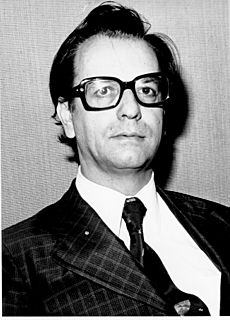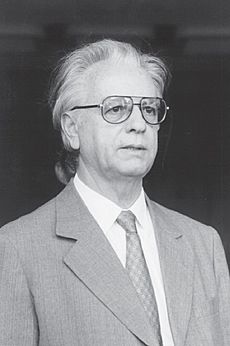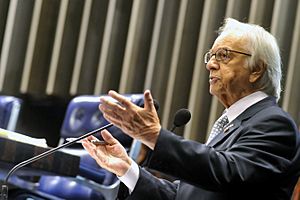Itamar Franco facts for kids
Quick facts for kids
Itamar Franco
|
|
|---|---|
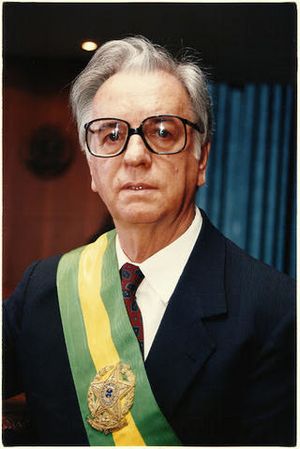
Official portrait, 1992
|
|
| President of Brazil | |
| In office 29 December 1992 – 31 December 1994 Acting: 2 October 1992 – 29 December 1992 |
|
| Vice President | None |
| Preceded by | Fernando Collor de Mello |
| Succeeded by | Fernando Henrique Cardoso |
| Vice President of Brazil | |
| In office 15 March 1990 – 29 December 1992 |
|
| President | Fernando Collor de Mello |
| Preceded by | José Sarney |
| Succeeded by | Marco Maciel |
| Senator for Minas Gerais | |
| In office 1 February 2011 – 2 July 2011 |
|
| Preceded by | Hélio Costa |
| Succeeded by | Zezé Perrella |
| In office 1 February 1975 – 15 March 1990 |
|
| Preceded by | José Augusto |
| Succeeded by | Matta Machado |
| Governor of Minas Gerais | |
| In office 1 January 1999 – 31 December 2002 |
|
| Vice Governor | Newton Cardoso |
| Preceded by | Eduardo Azeredo |
| Succeeded by | Aécio Neves |
| Mayor of Juiz de Fora | |
| In office 31 January 1973 – 15 May 1974 |
|
| Preceded by | Agostinho Pestana |
| Succeeded by | Saulo Pinto Moreira |
| In office 1 January 1967 – 31 December 1970 |
|
| Preceded by | Ademar de Andrade |
| Succeeded by | Agostinho Pestana |
| Diplomatic posts | |
| 2003–2005 | Ambassador of Brazil to Italy |
| 1996–1998 | Ambassador of Brazil to the Organization of American States |
| 1995–1996 | Ambassador of Brazil to Portugal |
| Personal details | |
| Born |
Itamar Augusto Cautiero Franco
28 June 1930 Brazilian territorial waters, Atlantic Ocean |
| Died | 2 July 2011 (aged 81) São Paulo, São Paulo, Brazil |
| Political party |
|
| Spouse |
Anna Elisa Surerus
(m. 1968; div. 1978) |
| Children | 2 daughters |
| Alma mater | School of Engineering of Juiz de Fora (B.A.I.) |
| Profession | Civil engineer |
| Signature |  |
Itamar Augusto Cautiero Franco (born June 28, 1930 – died July 2, 2011) was a Brazilian politician. He served as the 33rd President of Brazil from 1992 to 1994. Before that, he was the 21st Vice President of Brazil from 1990 until the previous president resigned. During his long career, Franco also worked as a Senator, a Mayor, an Ambassador, and a Governor. When he passed away, he was serving as a Senator for the state of Minas Gerais.
Contents
Early Life and Family
Itamar Franco was born early, while his mother was on a ship traveling between Salvador and Rio de Janeiro. He was officially registered in Salvador. His family came from Juiz de Fora, a city in Minas Gerais. He grew up there and became a civil engineer in 1955. He graduated from the School of Engineering of Juiz de Fora.
Political Career Highlights
Before Becoming Vice President
Franco started his political journey in the mid-1950s. He first served as an alderman (a local council member) and deputy mayor in Juiz de Fora. Later, he was elected mayor of the city twice, from 1967 to 1971 and again from 1973 to 1974.
In 1974, he stepped down as mayor and successfully ran for the Brazilian Senate, representing his home state of Minas Gerais. He quickly became an important figure in the Brazilian Democratic Movement (MDB). This party was the main opposition to the military government that ruled Brazil from 1964 to 1985. He served as a deputy leader in the Senate in 1976 and 1977.
He was re-elected as a senator in 1982. In 1986, he tried to become the governor of Minas Gerais but was not elected. During his time as a senator, Franco strongly supported bringing back direct elections for president. He also led the Liberal Party (PL) in the Senate.
As a member of the group that wrote Brazil's new Constitution, starting in 1987, Franco voted for many important changes. He supported equal rights for all people and better pay for workers. He also voted against bringing back the death penalty. He opposed the extension of President José Sarney's term and called for his removal due to disagreements with his actions. Interestingly, when Franco later became president, Sarney became one of his supporters.
Serving as Vice President (1990–1992)

In 1989, Franco joined a smaller party called PRN. He was chosen to be the running mate for presidential candidate Fernando Collor de Mello. Franco was a good choice because he came from a large state, unlike Collor, who was from a smaller one. This helped them gain more support.
Collor and Franco won the election by a very small margin against Luiz Inácio Lula da Silva, who would later become president himself.
Once in office, Franco often disagreed with President Collor. He even threatened to resign several times because he did not like some of the President's policies, especially how the country's businesses were being managed. He openly shared his disagreements.
On September 29, 1992, President Collor faced serious accusations and was removed from office by the Congress. According to Brazil's Constitution, a president who is removed from office has their powers suspended for 180 days. So, Itamar Franco became the acting president on October 2, 1992. Collor officially resigned on December 29, when it was clear he would be permanently removed. At that point, Franco formally became the President of Brazil.
When he first became acting president, many people in Brazil did not know who he was, even though he had been vice president for almost three years.
Presidency (1992–1994)
Leading Brazil's Economy
When Franco became president, Brazil was facing a very difficult economic time. Prices were rising incredibly fast, with inflation reaching over 1,100% in 1992 and nearly 2,400% in 1993. Franco was known for being a bit unpredictable, but he made a smart choice by picking Fernando Henrique Cardoso as his Finance Minister. Cardoso launched a plan called the "Plano Real" (Real Plan). This plan successfully brought the economy under control and stopped the rapid price increases.
In a unique move, just before taking office, Franco showed senators a paper listing all his personal money and properties. This showed his honesty. At first, about 60% of Brazilians approved of his work.
After the difficult presidency of Fernando Collor, Franco quickly put together a balanced team of ministers. He worked hard to get wide support from the Congress.
Key Decisions and Style
During his presidency, in April 1993, Brazil held a special vote. People voted on whether Brazil should remain a Republic or become a Monarchy again. They also voted on whether the government should be presidential (like the U.S.) or parliamentary (like the UK). Most people voted to keep Brazil a Republic with a presidential system. Franco himself preferred the parliamentary system.
In 1993, Franco stood firm against some military and civilian leaders who wanted to shut down the Congress. This showed his commitment to democracy.
His government is remembered for bringing back honesty and stability to the country, especially after the previous troubled presidency. President Franco himself kept his reputation for being honest. His personal style was seen as very different from his predecessor's, who was more formal. Franco's own behavior was sometimes described as unique or a bit unusual.
Near the end of 1993, Franco offered to resign so that an earlier election could be held, but Congress did not accept his offer.
By the end of his term, Franco's approval rating was very high, reaching almost 80–90 percent. He was the last President of Brazil who had not been directly elected to that office until May 2016.
Brazil's Role in the World
Even though he was sometimes seen as not having the best diplomatic skills, Franco is credited with a big idea: creating a free trade zone for all of South America. This idea was even praised by leaders like U.S. President Bill Clinton.
Also, during his time as president, Brazil signed important agreements. These included the Tlatelolco Treaty, which meant Brazil agreed not to develop nuclear weapons. This helped set Brazil on a path of peaceful nuclear energy use.
After His Presidency
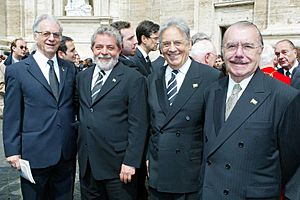
Franco was not allowed to run for president again in 1994. In Brazil, if a vice president takes over part of a president's term, it counts as a full term. At that time, presidents could not be re-elected immediately. Fernando Henrique Cardoso, who was Franco's Finance Minister, became the candidate to succeed Franco and was elected president in late 1994.
However, Franco soon became a strong critic of Cardoso's government. He disagreed with some of the decisions, especially about selling government-owned companies. After his presidency, he served as Brazil's ambassador to Portugal in Lisbon. Then he was the ambassador to the Organization of American States in Washington, D.C., until 1998.
Franco thought about running for president again in 1998, but he decided not to after the Constitution was changed to allow Cardoso to run again. However, in 1998, he was elected governor of Minas Gerais by a large number of votes. As soon as he became governor, he made a decision about the state's debt payments that caused some debate about the national economy. Itamar Franco served as governor until 2003. He chose not to run for re-election and supported the candidate who eventually won, Aécio Neves. After that, he was Brazil's ambassador to Italy until 2005. In the 2002 presidential election, Franco supported Luiz Inácio Lula da Silva, who was elected president.
In 2006, at age 76, he tried to get his party's nomination for president but was unsuccessful. He then supported Geraldo Alckmin against Lula. Even though he was considered a possible candidate for president again in 2010, he decided to run for Senator from Minas Gerais instead. He won that election.
Personal Life
Itamar Franco was divorced in 1978 and had two daughters. He wrote about 19 books, covering topics from nuclear energy to short stories.
Passing Away
Franco was diagnosed with leukemia, a type of cancer. He was admitted to the Albert Einstein Hospital in São Paulo on May 21, 2011. On June 28, his 81st birthday, his health got worse, and he developed severe pneumonia. He was moved to the intensive care unit and put on a breathing machine. He passed away on Saturday, July 2, 2011, after having a stroke.
President Dilma Rousseff declared seven days of mourning for him. His body was displayed in his political home city of Juiz de Fora and in Belo Horizonte, the capital of Minas Gerais. He was cremated on Monday, July 4, 2011.
Images for kids
See also
 In Spanish: Itamar Franco para niños
In Spanish: Itamar Franco para niños


